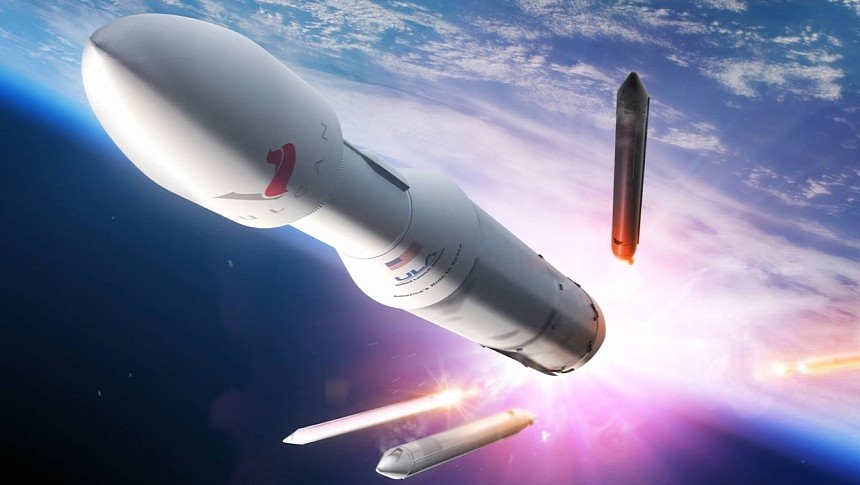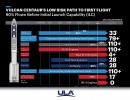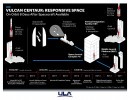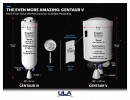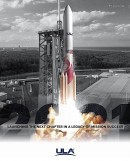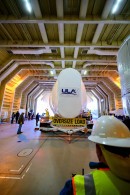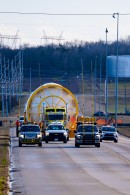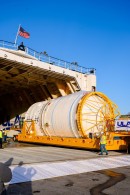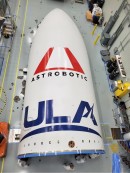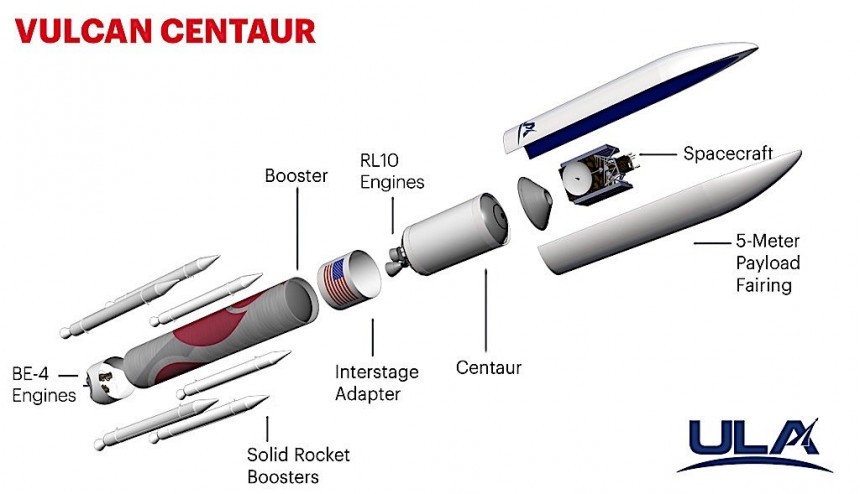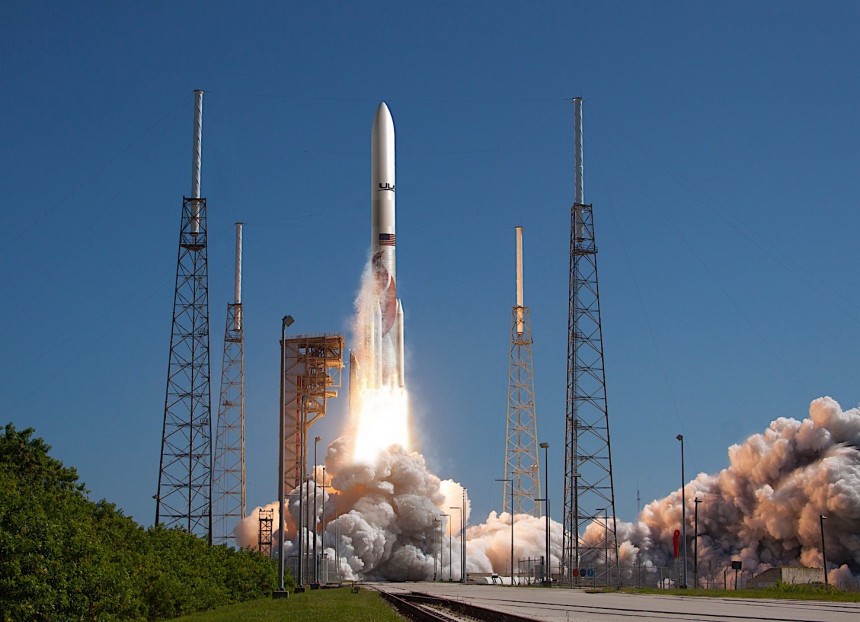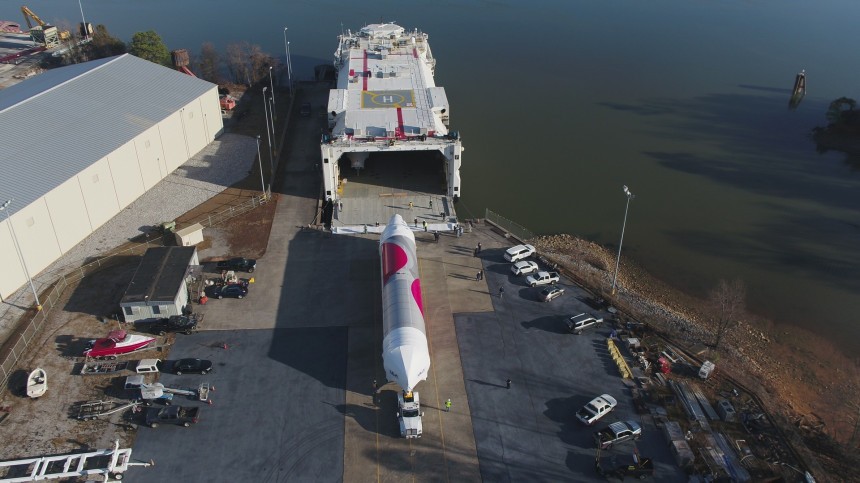As of November 2022, two American aerospace contractors have new spacecraft raring to go up into low-Earth orbit at the first sign of an opportunity in Boeing's Starliner capsule and Sierra Space's Dream Chaser space plane. But until their shiny new booster rocket tailored specifically for spacecraft of their ilk is ready, neither one is going to space. Thankfully, the wait appears to be close to its end. It also helps that the rocket seems pretty darn capable based on what's been said about it.
This is the Vulcan Centaur, and it's here to prove that SpaceX and Blue Origin aren't the only names in town regarding heavy-lift American booster rockets. In fact, Vulcan Centaur's manufacturer, United Launch Alliance, has been around almost as long as SpaceX. By re-manufacturing launch platforms from defunct aerospace companies to higher standards of quality and technological refinement than the originals, ULA's made what's old new again like no other in the history of space flight. In fact, Vulcan Centaur is ULA's first wholly bespoke booster vehicle not directly related to a legacy vehicle.
But while SpaceX and Blue Origin most often advertise themselves through their eccentric, lager-than-life billionaire leading men, ULA's historically chosen to let their products do the promotional work for them.
Indeed, it's almost bizarre to include the makers of established rockets like the Atlas and Delta series in the same category as flashy upstarts. Ones who had their start after SpaceX, in particular, but also others, opened the American space-travel sector private contractors operating independently from NASA. But as you'll find, the Vulcan Centaur is due to compete directly with the Falcon 9, Falcon Heavy, and Blue Origin New Glenn.
From that perspective, ULA is very much a member of the same club indeed. But what exactly makes Vulcan Centaur so capable that it serves as the spiritual successor to all-time-great booster rockets like the Delta IV? Like the Delta rockets before it, the name of the game for Vulcan Centaur is adaptability to changing mission directives and different varieties of payload. Lessons learned from the Delta and Atlas family of rockets initially designed by McDonnell Douglas and Convair, respectively, and now built by ULA, to apply modern propellant and rocket engine technology to a form factor known for considerable success.
With two booster stages to work with, supported by up to six GEM 63XL graphite-epoxy motor solid rocket boosters, ULA can pick and choose which configuration of SRBs is the most suitable for a specific mission. The ability to subtract SRBs down to zero for light satellite launches or increase them for human-crewed spacecraft like Starliner or Dream Chaser is one of the most vital points of appeal for NASA, which is currently spoiled for choice when it comes to capable booster rockets in 2023.
To make better sense of ULA's complicated list of Vulcan configurations, they've devised a clever designation system where the first letter, V, is the call sign for the rocket's first stage, its second letter, C, is the second stage, the SRB count, either zero, two, four, or six, is the third digit. Meanwhile, the fourth letter denotes the size of Vulcan Centaur's payload fairing, either the standard (S) 15-meter (51 ft) fairing or the long (L) 21.3-meter (70 ft) fairing. With the same diameter first-stage propellant tank as the soon-to-be-defunct Delta IV, it'd be easy to assume Vulcan Centaur would utilize the same combination of liquid hydrogen fuel and liquid oxygen oxidizer as its predecessor. But this would be false.
Like the ever-controversial SpaceX Starship, Vulcan Centaur will use a combination of cryo-cooled liquid methane and liquid oxygen to generate in the neighborhood of 4,900 kN (1,100,000 lbs) of thrust in its first stage booster. With two BE-4 liquid rocket engines in Vulcan Centaur's first stage built by Blue Origin of all people, it's clear that at least some degree of cooperation can indeed exist between the private American contractors all vying for lucrative NASA and ESA launch contracts. The BE-4 was chosen over Aeroject-Rocketdyne's AR1 engine, a decision finalized in September 2018.
But perhaps it's VC's second stage, the Centaur portion, that excites the most. Fresh from ULA's R&D facility, the ubiquitous Centaur stage found in various Atlas rockets and later variants of the Titan rocket family is all new for Vulcan Centaur. With two Aerojet-Rocketdyne RL10 liquid engines on offer very similar to the ones found in the Artemis Program's SLS Moon rocket, the new Centaur V upper stage will have some serious horsepower to play with in the upper fringes of the atmosphere before bursting through the Kármán line to low-Earth orbit and far beyond.
As much as 212 kN (48,000 lbs) of thrust is propelled out the rear end of this second-stage Centaur V booster. Compared to some twin-stage booster rockets now defunct that were all out of steam by the time they reached low-Earth orbit, Centaur V can keep chugging along to the upper limits of LEO, or tens of thousands of kilometers above sea level. So to say, not only can Vulcan Centaur ferry Dream Chaser and Starliner to rendevous with the International Space Station, but it can just as well boost interplanetary, or potentially even interstellar space probes, to an orbit that puts them on target for departure without spending its own vital fuel reserves.
Could Vulcan Centaur really launch the next spacecraft to crack interstellar space vis-à-vis the Voyager probes? Well, if a Titan IIIE booster with a long-antiquated variant of the Centaur stage could do it, Vulcan Centaur can likely do it even better. But for now, its first slot of missions, due to begin on Christmas Eve 2024, is more conventional in scope. With a single Peregrine lunar lander vehicle from Astroboic Technology as its first payload, Vulcan Centaur will help carry a 90-kilo (200-lb) payload, including scientific instruments and two small rovers, to a landing site near the massive Gruithuisen impact crater in the Lunar Northern Hemisphere.
So then, a pretty spectacular first mission if we do say so. But it only gets better from there. If all goes to plan, Sierra Space will launch its first test flight of the Dream Chaser in April 2024 aboard a VC2S configuration at Space Launch Complex 41 at the Cape Canaveral Space Force Station in Florida. It would mark the first time an American orbital space plane launched into space since Space Shuttle Atlantis touched down for the final time after STS-135 in 2011. From there, Vulcan Centaur is expected to service a National Security Space Launch (NSSL) program contract with the United States Space Force acting as mission control.
Later launches are slated to test Vulcan Centaur's ability to propel space probes well past low-Earth orbit. Using cutting-edge, "high-energy" orbits boosted in large part by Vulcan Centaur's turbo LS of a rocket engine. Military geostationary satellites are also in the cards for Vulcan Centa, But perhaps most importantly, Vulcan Centaur will contribute at least 38 launches to Amazon's Project Kuiper, a constellation satellite initiative to provide global access to high-bandwidth, low-latency internet access, which parallels SpaceX's wildly successful Starlink program.
The first two prototype satellites for Project Kuiper were launched aboard Atlas Vs in October 2023, and Vulcan Centaur is tasked with helping the system proliferate in orbit. All the while, future contracts for NASA and its aligned international space agencies like the ESA and JAXA could soon call ULA to place even more orders for future space missions. As a proverbial work mule for Western-aligned space agencies, ULA intends for Vulcan Centaur to be every bit as potent as its hyper-successful SpaceX competitors. Talks of a three-stage super-heavy variant are even in the works as well.
Safe to say, Cape Canaveral is going to be just as rife with ULA rocket activity next year as its surrounding swamps and lakes are with sharp-toothed reptiles.
But while SpaceX and Blue Origin most often advertise themselves through their eccentric, lager-than-life billionaire leading men, ULA's historically chosen to let their products do the promotional work for them.
Indeed, it's almost bizarre to include the makers of established rockets like the Atlas and Delta series in the same category as flashy upstarts. Ones who had their start after SpaceX, in particular, but also others, opened the American space-travel sector private contractors operating independently from NASA. But as you'll find, the Vulcan Centaur is due to compete directly with the Falcon 9, Falcon Heavy, and Blue Origin New Glenn.
From that perspective, ULA is very much a member of the same club indeed. But what exactly makes Vulcan Centaur so capable that it serves as the spiritual successor to all-time-great booster rockets like the Delta IV? Like the Delta rockets before it, the name of the game for Vulcan Centaur is adaptability to changing mission directives and different varieties of payload. Lessons learned from the Delta and Atlas family of rockets initially designed by McDonnell Douglas and Convair, respectively, and now built by ULA, to apply modern propellant and rocket engine technology to a form factor known for considerable success.
With two booster stages to work with, supported by up to six GEM 63XL graphite-epoxy motor solid rocket boosters, ULA can pick and choose which configuration of SRBs is the most suitable for a specific mission. The ability to subtract SRBs down to zero for light satellite launches or increase them for human-crewed spacecraft like Starliner or Dream Chaser is one of the most vital points of appeal for NASA, which is currently spoiled for choice when it comes to capable booster rockets in 2023.
Like the ever-controversial SpaceX Starship, Vulcan Centaur will use a combination of cryo-cooled liquid methane and liquid oxygen to generate in the neighborhood of 4,900 kN (1,100,000 lbs) of thrust in its first stage booster. With two BE-4 liquid rocket engines in Vulcan Centaur's first stage built by Blue Origin of all people, it's clear that at least some degree of cooperation can indeed exist between the private American contractors all vying for lucrative NASA and ESA launch contracts. The BE-4 was chosen over Aeroject-Rocketdyne's AR1 engine, a decision finalized in September 2018.
But perhaps it's VC's second stage, the Centaur portion, that excites the most. Fresh from ULA's R&D facility, the ubiquitous Centaur stage found in various Atlas rockets and later variants of the Titan rocket family is all new for Vulcan Centaur. With two Aerojet-Rocketdyne RL10 liquid engines on offer very similar to the ones found in the Artemis Program's SLS Moon rocket, the new Centaur V upper stage will have some serious horsepower to play with in the upper fringes of the atmosphere before bursting through the Kármán line to low-Earth orbit and far beyond.
As much as 212 kN (48,000 lbs) of thrust is propelled out the rear end of this second-stage Centaur V booster. Compared to some twin-stage booster rockets now defunct that were all out of steam by the time they reached low-Earth orbit, Centaur V can keep chugging along to the upper limits of LEO, or tens of thousands of kilometers above sea level. So to say, not only can Vulcan Centaur ferry Dream Chaser and Starliner to rendevous with the International Space Station, but it can just as well boost interplanetary, or potentially even interstellar space probes, to an orbit that puts them on target for departure without spending its own vital fuel reserves.
So then, a pretty spectacular first mission if we do say so. But it only gets better from there. If all goes to plan, Sierra Space will launch its first test flight of the Dream Chaser in April 2024 aboard a VC2S configuration at Space Launch Complex 41 at the Cape Canaveral Space Force Station in Florida. It would mark the first time an American orbital space plane launched into space since Space Shuttle Atlantis touched down for the final time after STS-135 in 2011. From there, Vulcan Centaur is expected to service a National Security Space Launch (NSSL) program contract with the United States Space Force acting as mission control.
Later launches are slated to test Vulcan Centaur's ability to propel space probes well past low-Earth orbit. Using cutting-edge, "high-energy" orbits boosted in large part by Vulcan Centaur's turbo LS of a rocket engine. Military geostationary satellites are also in the cards for Vulcan Centa, But perhaps most importantly, Vulcan Centaur will contribute at least 38 launches to Amazon's Project Kuiper, a constellation satellite initiative to provide global access to high-bandwidth, low-latency internet access, which parallels SpaceX's wildly successful Starlink program.
The first two prototype satellites for Project Kuiper were launched aboard Atlas Vs in October 2023, and Vulcan Centaur is tasked with helping the system proliferate in orbit. All the while, future contracts for NASA and its aligned international space agencies like the ESA and JAXA could soon call ULA to place even more orders for future space missions. As a proverbial work mule for Western-aligned space agencies, ULA intends for Vulcan Centaur to be every bit as potent as its hyper-successful SpaceX competitors. Talks of a three-stage super-heavy variant are even in the works as well.
